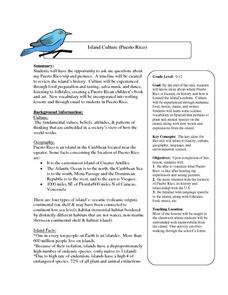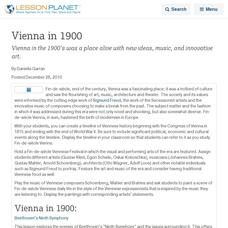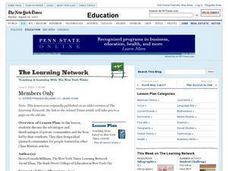Curated OER
Making a Pictorial Timeline
Learners create a pictorial timeline of a biographical character. In this timeline lesson, students create a slide show illustrating the life of the person from a biography they've read. Learners also use Kid Pix to create a pictorial...
Curated OER
Timeline of 9/11
Students explore the series of events that cumulated in the events of September 11, 2001. They understand the importance of the events of September 11, 2001 and the effect on US history. They createa timeline utilizing photos and visual...
Curated OER
Reign of Terror?
Students research acts of terrorism around the world over the past thirty years to create a visual timeline of these events for the classroom.
Curated OER
Letters from Rifka
Fourth graders read Letters from Rifka and discuss the feelings of people forced to leave their homes and countries. In this migration instructional activity, 4th graders relate their feelings about moving from their home forever....
Museum of Tolerance
The Pursuit of Democracy and Diversity: The Trial of Pro-Social Injustice in Historical Documents and Accounts
Class members investigate The Indian Removal Act of 1830, U.S. Theft of Mexican Territory Timeline, and President Abraham Lincoln’s letter to Horace Greeley, 1862, and then conduct a mock trial of each of these documents to determine...
Curated OER
Making Treaties and Weaving Wampum
Middle schoolers are exposed to the cultural and artistic importance of wampum belts and the importance of the belts in American history as markers of relations between the Native Americans and European settlers.
Curated OER
"Old 300"
Fourth graders combine art and history to assess the importance of the "Old 300." They explore a group of colonists that Stephen F. Austin brought to Texas as the first settlers and then create a time line of major events leading to the...
Curated OER
Ceramics: A Vessel into History
Students create a personal clay vessel that has a specific use or meaning in their contemporary culture, which could be discerned through study by future archeologists and art historians.
National First Ladies' Library
Who Invented Crayons?
Pupils use a specified website to study the history of Crayola crayons. In groups, they discover who invented the colors, their cost, and who thought of the name. Young scholars create a timeline of Crayola colors and choose one project...
Curated OER
Spice It Up!
Students analyze visual artifacts from Asian descent and follow the path of famous explorers on the Silk Road. For this Asian artifacts lesson plan, students use their senses to explore and grind spices using a mortar and pestle.
Curated OER
Island Culture: Puerto Rico
Students explore the culture of Puerto Rico. They create maps of Puerto Rico and the Caribbean. They work in small groups to research a decade in history and add drawings and pictures to a timeline of their decade. They practice...
Curated OER
Draw Me the Music
Students explore and investigate the foundation and history of jazz music. They listen to various pieces of music while creating drawings, develop a timeline of jazz history, and read and discuss biographies of famous jazz musicians.
Curated OER
Vienna in 1900
Vienna in the 1900's was a place alive with new ideas, music, and innovative art.
Curated OER
Debating the Bomb
Students research the repercussions of the development of the atomic bomb. In this history lesson, students read, reflect and discuss nuclear warfare and how it affected the population when it was introduced, as well as how it...
Curated OER
Law: Requiring HPV Vaccine
Students research the HPV vaccine and estimate its cost. They interview doctors and local health officials about it. Students write feature stories based on their research focusing on the timelines for implementation in their states or...
Curated OER
Timeline - United States and Germany, Before, During, and After World War II
Learners read novel Rosa's Miracle Mouse, research assigned years in small groups, and create timelines and Powerpoint presentations detailing interaction between Germany and the United States before, during, and after World War II.
Curated OER
Abraham Lincoln: The Face of War
Students compare life masks and photos of Abraham Lincoln that were made before and at the end of the Civil War. For this "Faces of War" lesson, students analyze images of Lincoln in a historical context and create a timeline of event.
Curated OER
Exploring Indiana: Tales, Timelines, and Trivia
Students record timelines of Indiana history and include events from their own personal history on it. After using various research sources, the record their timelines using the Timeliner software application. They share their timelines...
Curated OER
Carbondale: The Biography of a Coal Town
Students use a brief history of the growth and decline of the anthracite region in the state to create a photograph and map "peak shaped" time line. They practice map and photo analysis strategies to "read" photographs and maps.
Curated OER
Influences on Cultures
Middle schoolers examine a timeline of events of a specific cultural group. Using the internet, they research the cultural group using a worksheet to guide them. They present their information to the class and create a poster about the...
Curated OER
Historical Figures
Student research a "Historical Individual" using the Internet. They print a minimum of five articles and organize them. They create a visual biography of their historical figure.
Curated OER
Debating the bomb
High schoolers research how the development of the atomic bomb affected people in World War II. In this American History lesson plan, students participate in a debate about the bombs use. High schoolers investigate how it has...
Curated OER
Flawed Democracies
Ninth graders examine the struggle for equal opportunity. In this American Government lesson, 9th graders create a timeline outlining various groups' struggles for equal opportunity. Students research and construct a timeline to...
Curated OER
Members Only
Students discuss the advantages and disadvantages of private communities and the lives led by their residents. They design ideal planned communities for people featured in other Class Matters articles.























